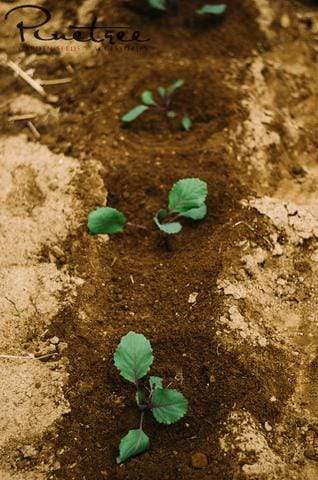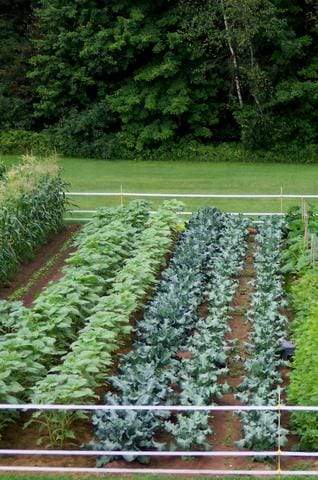Pinetree Garden Seeds Guide to Succession Planting
Perhaps because so many of Pinetree Garden Seeds customers are beginning or inexperienced home gardeners, our experts get asked a lot of questions about maximizing limited planting space. Whether you are tending potted plants on an apartment rooftop terrace or trying to feed your family through the winter on just one acre, getting the most from every inch of soil is a common gardening goal.
Sometimes gardeners want to harvest more of a particular crop. (If you enjoy putting up pickles or preserving your own salsas, tomato sauces, or jams and jellies, being able to harvest multiple batches of key ingredients can be a huge help.) Sometimes gardeners want to get more variety from their harvest or test different varieties of seeds. And sometimes, gardeners want to extend the season for heat-averse crops like sugar snap peas, microgreens, or lettuce, or make sure they always have fresh herbs on hand to season their meals.
Pinetree Garden Seeds is one of the few seed sellers to offer non-GMO hybrid, organic and heirloom seeds in smaller quantities at affordable prices—just a couple of dollars each—and our commitment to providing people-sized portions of premium seeds has taught us a lot about how to make the most of every precious packet.
Our secret? Succession planting. The ancient, time-tested technique times the planting and placement of seeds in your garden to create a longer, more varied, and more generous harvest, and we can show you how!
Our guide to succession planning shows how to increase the yield, variety, and longevity of your growing season no matter which zone you happen to garden in. While gardeners with longer growing seasons are given more opportunities to harvest successive plantings, gardeners with shorter seasons can significantly boost the productivity of their garden plot. For more detailed planting and sample garden plans, we recommend researching succession planting for your microclimate.
Pinetree Garden Seeds Succession Planting Guide
There are four main ways to use succession planting in your garden, and the type of succession planting you choose will be tied to your gardening goals.
Planting different types of crops in succession.
The first type of succession planting takes the seasonality of each crop into 
account. The smart succession gardener plants early crops first—carrots, peas, radishes, rhubarb, spring greens—and follows up their harvest with a second planting of seeds in the same space that thrive in the summer heat, like basil, peppers, eggplant, or wax beans. And when those summer stalwarts bolt, they plant crops capable of growing through the cooler temperatures and shorter days and early frosts of fall, like kale and chard, or crops that need to overwinter, like garlic. And anytime you find empty space, we recommend starting some herbs.
This type of succession planting requires you to keep an eye on your soil. Make sure you replenish essential nutrients with compost or organic fertilizers, like seaweed, so each planting gets the sustenance it needs.
If you want to grow more cops but feel constrained by your available space, or if you want to harvest throughout the growing season, planting in waves works wonders.
Planting the same crop isn't succession.
Can’t get enough of your favorite variety of lettuces and greens, string or wax beans, or crisp, tender carrots? The second type of succession planting—planting the same variety of seeds in staggered intervals of time—can really stretch your growing season and make eating and preserving your harvest more manageable.
First, decide how much of your garden you want to dedicate to a particular crop but don’t plant that space all at once. Plant a couple of rows. Then, a week or two later, plant a few more. Adding a new row of seeds or seedlings in intervals will make sure your crop doesn’t ripen all at once. Each planting is ready to pick when you want it and your harvest is easy to keep up with.
Our trial gardens manager, Jaci, plants one or two cucumber plants as soon as possible so she can enjoy that fresh cuke flavor early in the summer. Then a few weeks later, when the soil is nice and warm, she goes back and plants out a whole row for her pickles. You can push these plantings further than you think, particularly with “baby vegetables”—crops that can be harvested and consumed before they fully mature, like salad greens, carrots, beans, and beets.
If you get overwhelmed by baskets of vegetables and want to reduce waste, the second type of succession planting is perfect for you.
Plant different but complementary crops at the same time (intercropping)
 The trickiest of the succession planting methods, intercropping combines two types of plants in one growing space. Not every plant will take to being “twinned” with a different type of crop, so understanding the unique needs of your seeds is essential to making mixed plantings that make sense. Certain combinations of plants (like lettuce and cabbage, or onions and peas) can actually inhibit growth, not support it, so be sure you are planting in complementary pairs:
The trickiest of the succession planting methods, intercropping combines two types of plants in one growing space. Not every plant will take to being “twinned” with a different type of crop, so understanding the unique needs of your seeds is essential to making mixed plantings that make sense. Certain combinations of plants (like lettuce and cabbage, or onions and peas) can actually inhibit growth, not support it, so be sure you are planting in complementary pairs:
- Shade & Sun
- Tall & Short
- Different Growth Rates
Plant different varieties of the same crop at the same or different times.
Did you know that some tomato plants set their fruit all at once and others set fruit throughout the season? Or that some watermelons and muskmelons are bred to ripen early while others take weeks longer to mature? The fourth kind of succession planning combines different varietals of the same crop to get a bigger, longer harvest from the same acreage. By planting a mix of quick-growing with slower maturing types of fruits and vegetables, you can keep your kitchen stocked with your favorite ingredients all season long.
This type of succession also planting requires a good understanding of the seeds you are planting. What growing conditions do they prefer? How long will they take to mature? For instance, you can’t wait until your spring crops are harvested to plant a vine-like pumpkins.
Pinetree Garden Seeds stocks such a wide range of organic and heirloom seeds that this is, perhaps, our favorite succession planting method. It isn’t just that one type of English pea or bush bean will grow faster than another that makes this approach so magical. It’s the diversity of tastes, textures, and colors you can discover within one type of vegetable that makes this type of succession planting so much fun to explore. If you love mixing, matching, and serendipitous surprises, this is the succession planting method for you.

Let us know what type of succession planting you try this season and how it goes! Our garden experts are always on hand to answer questions and make recommendations. We want to help you go out there and get the most out of every bit of your garden!


Native American three sisters is now on my list. Any suggestions as to plant types and spacing of corn. Thanks!
Thanks for the very informative article on using limited garden space. As an vid Gardner for some 60 years I can confirm the information you have provided. With planning and organization fresh home grown veggies are a year around treat. As you plan, do not forget to take into consideration of how much produce your family uses. It is really nice to have homegrown produce, but it becomes wasteful if you grow more than you use. ’If that happens, share with neighbors and friends. I often take the extra to church to give to folks there. I am often asked if I have any extra so I take the opportunity expound on home gardening!
My tomato’s and cucumbers and doing super ,The Akila purple eye Daisy seeded in peat trays but did not grow in my soil. must have to check on soil type? Thank you for offering gardening advice helpful .. First time customer..